AUDI A5 COUPE 2010 Owners Manual
Manufacturer: AUDI, Model Year: 2010, Model line: A5 COUPE, Model: AUDI A5 COUPE 2010Pages: 360, PDF Size: 84.39 MB
Page 121 of 360

_______________________________________________ A_ d_ a ---=- p_t_ i_v _e_ c_ r_ u_ i_ s _e_ c_ o_ n_t_ r _o _ l __ llll
& WARNING (continued)
• Always turn off adaptive cruise control when entering turn
lanes, highway exit lanes and construction zones or similar situa
tions because the vehicle will automatically accelerate to the
stored speed.
• Never rest your foot on the accelerator pedal, especially when
the adaptive cruise control is being used because doing so will override the braking function and prevent the brakes from being
applied by the system when it detects a situation when the brakes
must be applied.
• Always remember that the adaptive cruise control has limits -
it does not react when you drive towards an obstacle or some
thing else on or near the road that is not moving, such as vehicles stopped in a traffic jam, a stalled or disabled vehicle.
• Always remember that the adaptive cruise control cannot
detect a vehicle that is driving towards you in your traffic lane and
that it cannot detect narrow vehicles such as motorcycles and
bicycles .
[ i] Tips
• For safety reasons, the stored speed is deleted when the ignition
is turned off.
• The Electronic Stabilization Program (ESP) and the Anti -Slip
Regulation (ASR) cannot be deactivated when the adaptive cruise
control is switched on. If the ESP and the Anti -Slip Regulation (ASR)
has been deactivated and you then switch on the adaptive cruise
control, the ESP function will also be activated automatically.
• Damage caused by accidents (e.g. if the vehicle is damaged
when parking) can affect the radar sensor settings. This can cause
the system to malfunction or switch off completely.
• The radar sensor cover is heated. In winter conditions, you
should still check before driving to make sure it is free of ice and
snow. If necessary, clean the area near the radar sensor carefully
=>
page 118, fig. 122.
Controls and equip
ment
• To ensure that the radar sensor is not blocked, foreign objects
(e.g. stickers, add -on parts) must not cover the area near the radar
sensor=>
page 118, fig. 122. The area near the radar sensor must
not be painted, either.
• For Declaration of Compliance to United States FCC and Industry
Canada regulations =>
page 342. •
Applies to vehic les : with adaptive crui se cont rol
How does adaptive cruise control work?
Vehicles traveling ahead are detected with the aid of a
radar sensor.
I==;.===============-. ~
~
ll!
Fig. 123 Radar sensor
measurement range
A radar sensor is built into the front of the vehicle=> fig. 123, which
is subject to certain system limits=>
page 130. Stationary objects
are not taken into consideration. The system is intended to measure
the distance to reflective surfaces. The system responds after the
distance measurement has taken place. If a measurement is not
possible, the system does not respond.
Open road
When the road is clear, the adaptive cruise control works like cruise
control. It maintains a constant target speed specified by the driver .~
I • •
Page 122 of 360
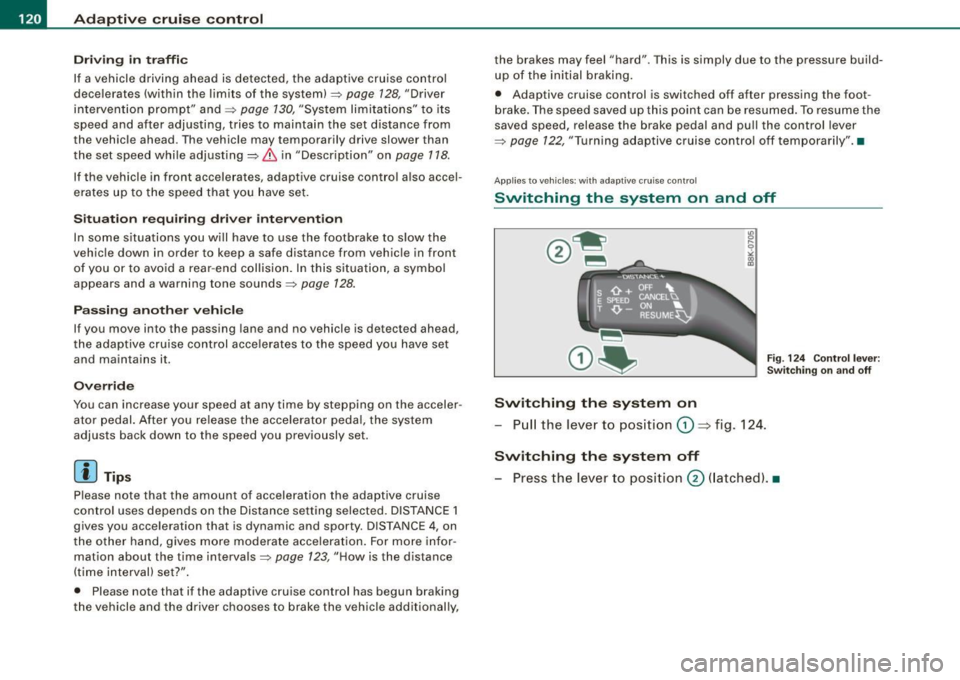
• ..__A_ d_ a-'- p_t _iv _ e_ c_r _u _ i_s _e _ c_o_ n_t _r _o _l _____________________________________________ _
Driving in t raffi c
If a vehicle driving ahead is detected, the adaptive cruise contro l
decelerates (within the limits of the system)~
page 128, "Driver
interven tion prompt" and~
page 130, "Sys tem limita tions" to its
speed and after adjusting, tries to mainta in the set d istance from
the vehicle ahead . The vehicle may temporarily drive slower than
the set speed while adjusting~
& in "Description" on page 118 .
If th e vehicle in front acc ele rates, adaptive cruise control also acce l
e rates up to the speed that you have set.
Situ ation r equiring d river interve ntion
In some s ituations you will have to use the foot brake to s low the
vehic le down in order to keep a safe distance from vehic le in front
of you or to av oid a rear -end c ollisi on. I n this s ituati on, a sy mbol
appears and a warning tone sounds:::::,.
page 128.
Pas sing another vehicle
If you move into the passing lane and no vehicle is det ected ahead ,
the adaptive cr uise control acce lerates to the speed you have set
and maintains it.
Override
You can increase your speed at any time by stepping on the acceler
ator pedal. After you re lease the acce lerat or pedal, the system
adjusts back down to the speed you previously set .
[ i ] Tips
Please note that the amount of acceleration the adaptive cruise
con tro l uses depends on the Dista nce se tting selec ted . DISTANC E 1
gives you acce leration that is dynamic and sporty . D IS TA NCE 4, on
the o ther hand, gives more modera te acce leration . For more infor
mation about the time intervals:::::,.
page 12 3, "How is the distance
( t ime in terval) set?".
• Please note that if the adaptive cruise control has begun braking
th e vehicle and the driver chooses to brake the veh icle additional ly , the brakes may feel "hard".
This is simply due to the pressure build
up of the initial braking.
• Adaptive cruise control is switched off after pressing the foot
b rake . The speed sav ed up thi s poi nt can be resumed. T o re sume the
saved speed, release the brake pedal and pu ll the control lever
:::::,. page 122, "Turning a daptive cruise c ontro l off temporarily ".•
Ap plie s to v ehic les: with a daptiv e c ruis e cont rol
Switching the system on and off
F ig . 12 4 Control l ever:
Swit chi ng on and off
Switching the system on
- Pull the leve r to pos ition
(D ~ fig. 1 24.
Switching the system off
- Press the le ver to posi tion
0 (latch ed). •
Page 123 of 360
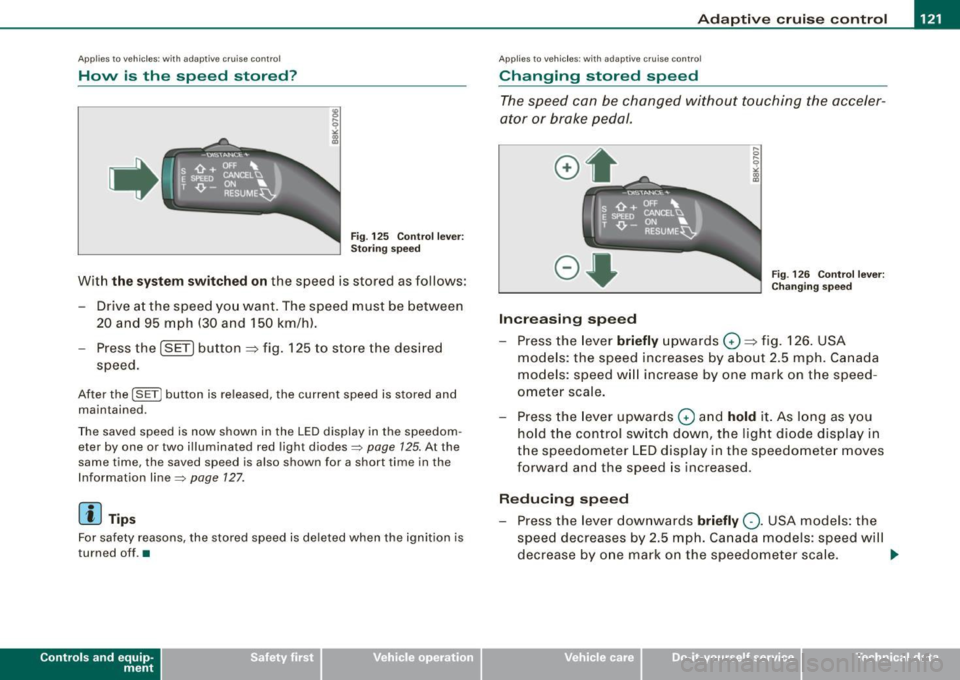
Adaptive cruise control -____________ ____,_ __ ___.
Applies to vehic les : w ith ada ptive cru ise cont rol
How is the speed stored ?
Fig. 125 Control lever:
Storing speed
With the system switched on the speed is stored as follows:
- Drive at the speed you want. The speed must be between
20 and 95 mph (30 and 150 km/hl.
- Press the
I SET I button ~ fig. 125 to store the desired
speed.
After the I SET j button is released , the current speed is stored and
maintained .
The saved speed is now shown in the LED display in the speedom
eter by one or two illuminated red light diodes=>
page 125. At the
same time, the saved spe ed is also shown for a short time in the
Information line::::>
page 127.
[ i J Tips
For safety reasons, the stored speed is deleted when the ignition is
turned o ff . •
Con tro ls and eq uip
ment
A pp lies to veh ic les: with ada ptive cru ise cont rol
Changing stored speed
The speed can be changed without touching the acceler
ator or brake pedal.
Increasing speed
,... 0
~
ill
Fig . 126 Control lever:
Changing speed
- Press the lever briefly upwards G) ~ fig. 126. USA
models: the speed increases by about 2.5 mph . Canada
models : speed will increase by one mark o n the speed
ometer scale.
- Press the leve r upwards
0 and hold it. As long as you
hold the control switch down , the light diode display in
the speedometer LED display in the speedometer moves
forward and the speed is increased .
Reducing speed
- Press the lever downwards briefly Q. USA models: the
speed decreases by 2.5 mph. Canada models: speed will
decrease by one mark on the speedometer scale. _,.
Vehicle care I I irechnical data
Page 124 of 360
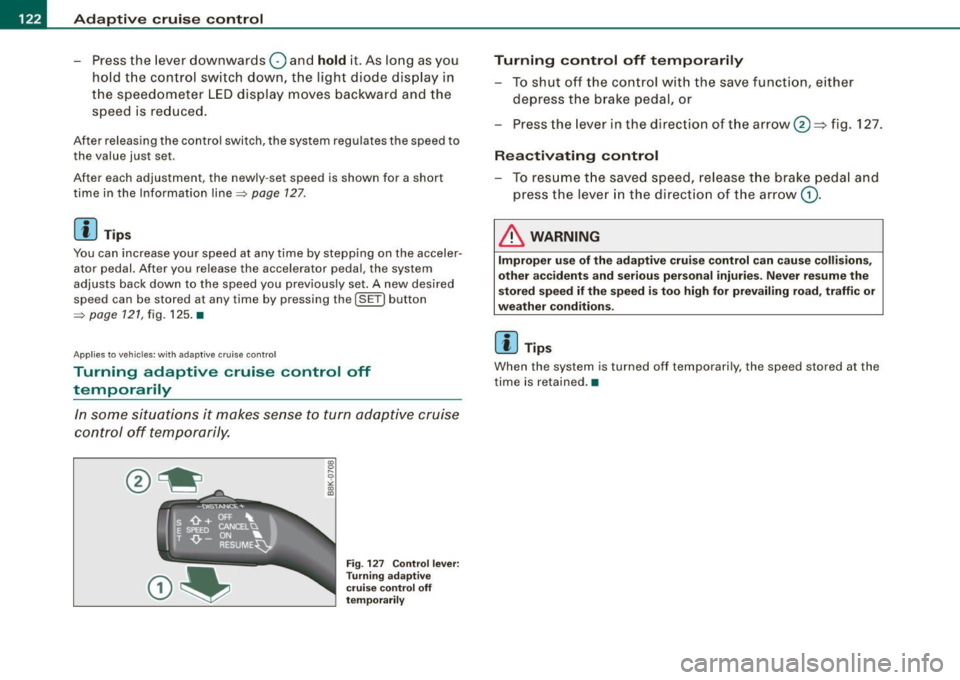
-Adaptive
cruise control "----'-----------------
- Press the lever downwards Q and hold it. As long as you
hold the control sw itch down, the light diode dis play in
the speedometer L ED display moves backward and the
speed is reduced.
After releasing the c ontro l switch, the system regulates the speed to
the value just set .
After each adjustment, the newly -set speed is shown for a short
t ime in the Information line => page 127.
[ i ] Tips
You can increase your speed at any time by stepping on the acceler
ator pedal. After you re leas e the accel erator pedal, the system
adjusts back down to the speed you previously se t.
A new desired
spe ed can be stored at any time by pressing th e [SET] button
~ page 121, fig. 125. •
A pplies to v ehi cles : with ada ptive cruis e contro l
Turning adaptive cruise control off
temporarily
In some situations it makes sense to turn ad aptive cruise
control off temporarily.
Fig . 127 C ontrol l ever :
T urnin g ad aptiv e
c rui se con trol off
temporari ly
Turning control off temporarily
- To shut off the control wit h the save function, either
depress the brake pedal, or
- Press the lever in the direction of the arrow
0 =} fig. 127 .
Reactivating control
- To resume t he save d speed, re lease t he brake peda l and
p ress the lever in the directio n of the arrow
G) .
& WARNING
Improper u se o f the adaptive crui se control can cau se collision s,
other ac cidents and serious personal injur ie s. Never r esume the
s tored speed i f the speed i s too hig h for prevail ing road, traffic or
weathe r cond iti ons.
[ i ] Tip s
When the system is turned off tempo rari ly, the speed stored at the
time is retai ned .•
Page 125 of 360
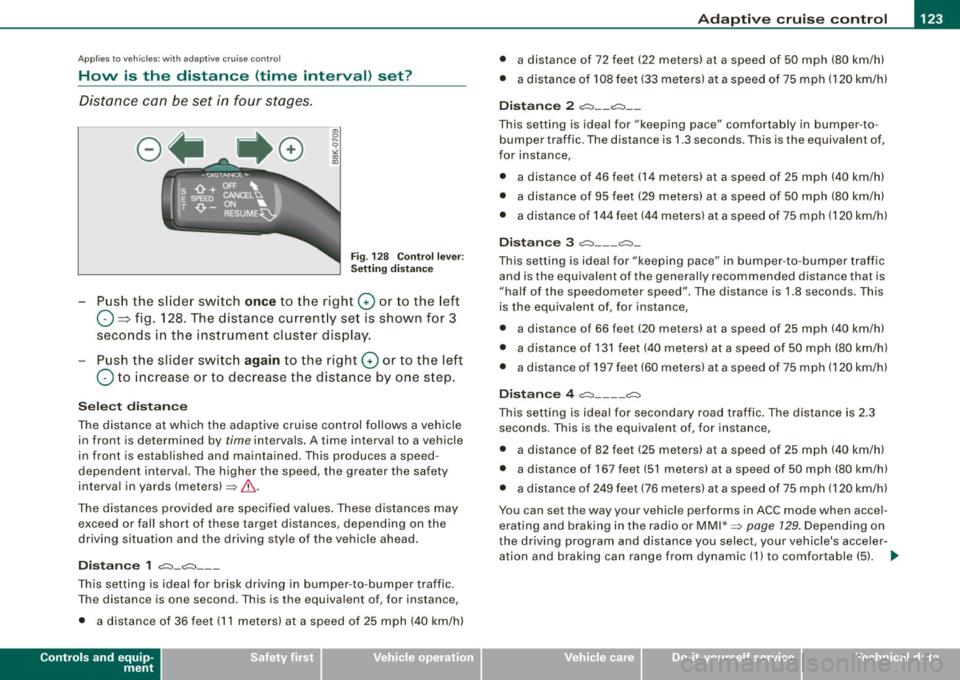
_____________________________________________ A_d_ a _.!,. p __ t __ iv _ e_ c_r _u _is _ e_ c _ o_n_ t_ r_ o _ l __ lJIII
Applies to vehic les: with adapt ive cru ise contro l
How is the distance (time interval) set?
Distance con be set in four stages .
m 0 [;; ,.: 00 a,
Fig. 128 Control lever:
Setti ng distance
-Push the s lider switch onc e to the right 0 or to the left
0 ~ fig. 128. The distance currently set is shown for 3
seconds in the inst rument cluster display.
- Push the slider switch again to the right 0 or to the left
0 to increase or to decrease the distance by one step.
Selec t d ista nce
The distance at whic h the adaptive cruise control follows a vehic le
in front is determined by
time intervals. A time interva l to a vehicle
in front is established and maintained . This produces a speed
dependent interval. The higher the speed, the greater the safety
interva l in yards (meters) =>& .
The distances provided are specified values . These distances may
exceed or fall short of these target distances, depending on the
driving situa tion and the driving style of the vehicle ahead .
Dista nce 1 e::::,_e::::, __ _
This setting is idea l for brisk driving in bumper -to-bumper traffic.
T he distance is one second. This is the equivalent of, for instance,
• a dis tance of 36 feet (1 1 meters) at a speed of 25 mph (40 km/h)
Controls and equip
ment
• a distance of 72 feet (22 meters) at a speed of 50 mph (80 km/h)
• a distance of 108 feet (33 meters) at a speed of 75 mph (120 km/h)
Distance 2 e::::, __ e::::, __
This setting is ideal for "keeping pace" comfortably in bumper-to
bumper traffic. The distance is 1.3 seconds. This is the equivalent of,
for instance,
• a distance of 46 feet (14 meters) at a speed of 25 mph (40 km/h)
• a distance of 95 feet (29 meters) at a speed of 50 mph (80 km/h)
• a distance of 144 feet ( 44 meters) at a speed of 75 mph (120 km/h)
Dista nce 3 e::::, ___ e::::,_
This sett ing is idea l for "keeping pace" in bumper -to -bumper traffic
and is the equivalent of the generally recommended distance that is
"ha lf of the speedometer speed" . The distance is 1.8 seconds . This
is the equivalent of, for instance,
• a distance of 66 feet (20 meters) at a speed of 25 mph (40 km/h)
• a distance of 131 feet (40 meters) at a speed of 50 mph (80 km/h)
• a distance of 197 feet (60 meters) at a speed of 75 mph (120 km/h)
Dista nce 4 e::::, ____ e::::,
This setting is idea l for secondary road traffic . The distance is 2.3
seconds . This is the equivalent of, for instance,
• a distance of 82 feet (25 meters) at a speed of 25 mph (40 km/h)
• a distance of 167 feet (51 meters) at a speed of 50 mph (80 km/h)
• a distance o f 249 feet (76 meters) at a speed of 75 mph (120 km/h)
You can set the way your vehicle performs in ACC mode when accel
erating and braking in the rad io or MMI*
~ page 129. Depending on
the driving program and distance you select, your vehicle's acceler
ation and braking can range from dynamic (1) to comfortable (5). .,..
I • •
Page 126 of 360

• ..__A_ d_ a-'- p_t _iv _ e_ c_r _u _ i_s _e _ c_o_ n_t _r _o _l _____________________________________________ _
Driving pro
gram
Di sta nce 1
Distance 2
D ist an ce 3
& WARNING
dynamic
1
2
2
3
standard
2
3
3
4
comfort
3
4
4
5
-
When setting the distance , the driver is responsible for adhering
to the respective national and country -specific regulations.
• Following other vehicles too closely increases the risk of colli
sions and serious personal injury .
• Setting short distances to the traffic ahead reduces the time
and distance available to bring your vehicle to a safe stop and
makes it even more necessary to pay close attention to traffic .
• Always use good judgment and select a safe following distance
for the traffic , road and weather conditions.
[ i J Tips
T he di stance se tting is re set to the factory defa ult DISTANCE 3 the
next time the ignition is turned on. •
Driver information
Applies to vehic les: with adapt ive cruise contro l
Displays in the instrument cluster
Dependin g o n the driving si tuati on, driver inform ation is
dis pla yed in the i nstr umen t clus ter.
F ig . 129 Overview instrument clu ste r
© Speedome ter and indicator lig ht dis play
® Displ ay in the instru ment clus ter
© M essage in the instr ument clus ter disp lay
© Speedometer and indicator light display
Im port ant inf orm ati on c once rning v ehicle opera tion with a daptiv e
cruise control is shown in display area@. T he desired speed you
s et is in dica ted in the sp eedometer ( LED l igh ts a rou nd th e e dge).
T he indicator lig hts show whether the system has detected a v ehic le
t rave ling ahead . ..,
Page 127 of 360

Adaptiv e c ruis e co ntrol -
--------------=-----
@ Displ ay i n th e instrum ent clu ste r
In disp lay area @information from the navigation system * and the
trip computer is displayed in addi tion to informa tion about adaptive
cruise cont rol.
You can select among the different informat ion by repeated brief
taps on th e [
RESET) button on the w indshi eld wiper lever
=:> page 25 , "Operation" .
© Sta tus in dica tor
The information in area © is not displayed permanently. Informa
tion is displayed only if you set or change the sp eed setting , change
the time interval, when messages are disp layed or if the adaptive
cruise control is turned off for safety reasons. •
Applies to veh ic les: w ith ada ptive cru ise cont ro l
Speedometer and indicator light display
----
- -
- -
@ ®
Desir ed speed
- -
--
Fig . 130 I nstrum ent
c lus ter : Ind icato r ligh t
The desired speed set by the driver is displayed by a red LED in the
LED display in the speedometer.
If the desired speed was set between two lines on the speedometer
using th e
[S ET) button , the two closest light diodes will come on
=>
page 124 , fig. 129 .
Controls and equip
ment
The system al lows only speeds from 20 to 95 mph (30 to 150 km/h)
to be set. This speed range is faintly i lluminated in the speedometer
(LED ligh ts).
Indicator light s (symbols )
• © Open road : The indicator l ight shows that adaptiv e cruise
control is active and that no object is ahead o f the vehicle. A stored
speed requested is maintained .
• @ Driv ing in traffic : The indicator light indicates tha t an objec t
has been detected traveling in front. Your speed is adjusted
according to the speed of the vehicle in front . The adap tive cruise
control acce lerates and brakes automatical ly within the system's
operat ion parameters.
• ©
Driver inter venti on prompt : The red flashing warning l ight
means
Reque st for driver t o assume control. You as the driver must
slow the vehic le with the foot brake. The symbol tells you that the
adaptive cr uise control is not able to slow the vehicle down enough
to keep a enough distance to the vehicle in front of you . An warning
tone wi ll a lso sound when the symbol appears . For more informa
tion about the driver intervention prompt =>
page 128.
[ i ] Tip s
• If you use the acce lerato r to go faster than the speed of the
object ahead of you, the
dri ver intervent ion prompt wi ll not be
accompanied by a wa rning signal.
• I f the speed you previous ly set is exceeded, the indicator light in
the speedomete r wi ll switch off. •
I • •
Page 128 of 360
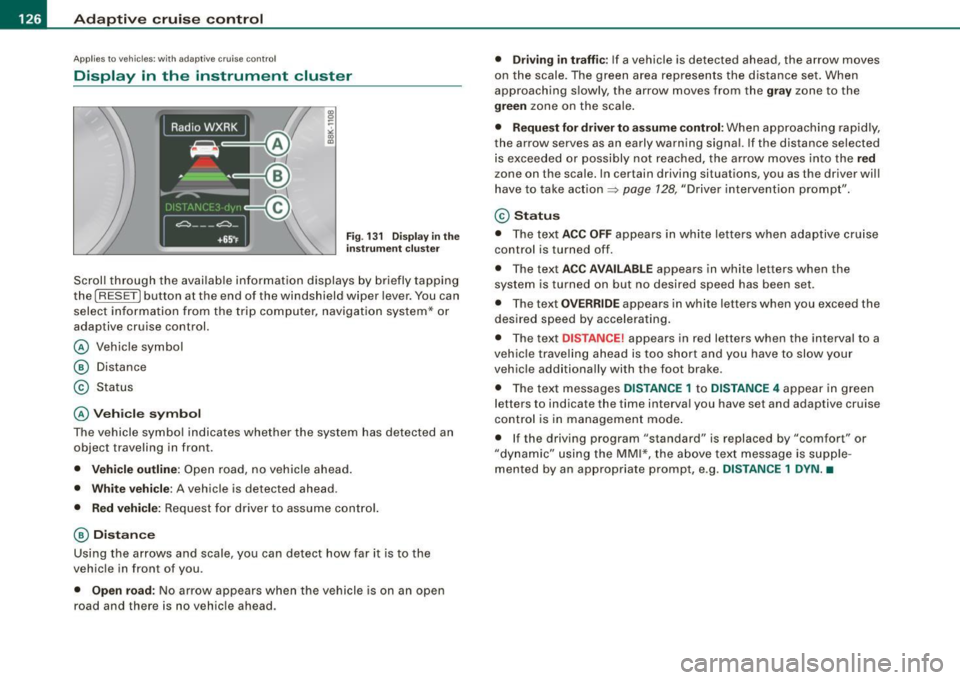
• ..__A_ d_ a-'- p_t _iv _ e_ c_r _u _ i_s _e _ c_o_ n_t _r _o _l _____________________________________________ _
Applies to ve hicles : w it h ada ptive c ruise cont rol
Display in the instrument cluster
F ig . 13 1 Di spl ay in the
in strum en t c luster
Scroll through the avai lab le information displays by briefly tapping
the
I RESET] button at the end of the windshield wiper lever. You can
select information from the trip computer, navigation system* or
adaptive cruise control.
@ Vehicle symbol
@ Dis tance
© Status
@ Veh icle sy mbol
The vehicle symbol indicates whether the system has detected an
object traveling in front.
• Vehicle outl in e: Open road, no vehicle ahead .
• Whit e vehi cle : A vehicle is detected ahead .
• Red vehicle: Request for driver to assume cont ro l.
@ Distance
Using the arrows and scale, you can detect how far it is to the
vehic le in front of you .
• Open road: No arrow appears when the vehicle is on an open
road and there is no vehicle ahead .
• Driving in traff ic: If a vehicle is detected ahead, the arrow moves
on the scale . The green area represents the d istance set . When
approaching s lowly, the arrow moves from the
gray zone to the
green zone on the scale .
• Reque st for driver to as sume control : When approaching rapidly,
the arrow serves as an early warning signal. If the distance selected
is exceeded or possibly not reached, the arrow
moves into the red
z one on the scale. In certain driving si tuations, you as the driver will
have to take action ::::,
page 128, "Driver interventio n promp t" .
© Status
• The tex t ACC OFF appears in white letters when adaptive cru ise
contro l is turned off.
• T he text
ACC AVAILABL E appears in white letters when the
system is turned on but no desired speed has been set .
• The text
OVE RRIDE appears in white letters when you exceed the
desired speed by accelerating .
• The text
DISTANCE! appears in red letters when the interval to a
vehic le trave ling ahea d is too short and you have to slow y our
vehic le additionally with the foot brake .
• The text messages
DISTANCE 1 to DISTANCE 4 appear in green
letters to indicate the time interva l you have se t and adaptive cruise
co ntrol is in ma nagement mode .
• I f the driving program "standard" is replaced by "comfor t" or
" d ynamic" usi ng the MMI*, the a bove text message is supp le
mented by an appropriate prompt , e.g .
DI STANCE 1 DYN . •
Page 129 of 360

_____________________________________________ A_d_ a __,_ p_t_iv _ e_ c_r _u _is _ e_ c _ o_n_ t_ r_ o _ l __ !II
Ap plies to vehic les: with adapt ive cruise cont rol
System status indicator
The text messages and symbols shown in this area of the
display are not displayed perm anently.
T ime in ter va ls (s uch a s c::;, __ __ c::;, }
Fig . 132 System
sta tus i ndicator
The different symbols for the time intervals appear if you change the
settings ::::> fig. 132 .
The text message ... (three whi te dots) appears if a setting cannot be
implemented with the operating lever . The following are possib le
reasons :
• If you pull the control lever towards you to resume speed but no
requested speed was set .
• If you push the lever up to increase (or down to reduce) speed
when no speed has been set previously .
• I f you push the lever up to increase (or down to reduce) speed
and this speed is outside the range from 20 to 95 mph (Canada
models : 30 to 150 km/h) .
ACC functi onal it y limited
The text message ACC fun ctio na lit y lim ited appears when the ACC
system does not detect any objects over an extended time period.
For the time being, the distance to vehicles up ahead is not being
Controls and equip
ment
controlled . The ACC system is not switched off, so increased alert
ness is required. The following may be reasons for the text message
ACC Functiona lly limited:
• The ACC sensor is dirty. The ACC system is not reacting, or is not
react ing correctly, to veh ic les traveling ahead.
• I t is possible that you are driving on a road with very light traffic
without anything at the side of the road (e.g. guard rai ls, traffic
signs, trees). As soon as a vehicle is detected by the system again,
it returns to its control range and the text message disappears .
The ACC sensor is located in the right front trim grille::::>
page 118,
fig. 122 . If there is a loss of operation due to heavy contamination,
this area should cleaned to restore proper operation .
ACC not available
The text message ACC not available appears , for example, if the
temperature of the brakes is excessive. Adaptive cruise control is
temporarily not availab le . A warning tone sounds as a reminder .
ACC not a vailable !
The text message ACC not ava ila ble! appears in the event of a
malfunction . Adaptive cru ise control is turned off . A warning tone
sounds as a reminder. Have the system inspected by a qua lified
dea lership .
ACC sensor blo cked !
The text message ACC s ensor blocked ! appears when the ACC
system can no longer guarantee safe detection of objects. Adaptive
cruise control is turned off . A warning tone sounds as a reminder.
To decide whether it is necessary to switch off the ACC (ACC sensor
b locked
!) or if it is only a temporary condition (ACC F unctionally
limited), the system wi ll a lso takes into consideration the outside
temperature and/or the windshield wiper operation.
The ACC senso r is dirty or b locked (e .g . leaves, snow).
The sensor should be cleaned to restore proper sensor function
::::>
page 118, fig. 122 .
I • •
Page 130 of 360
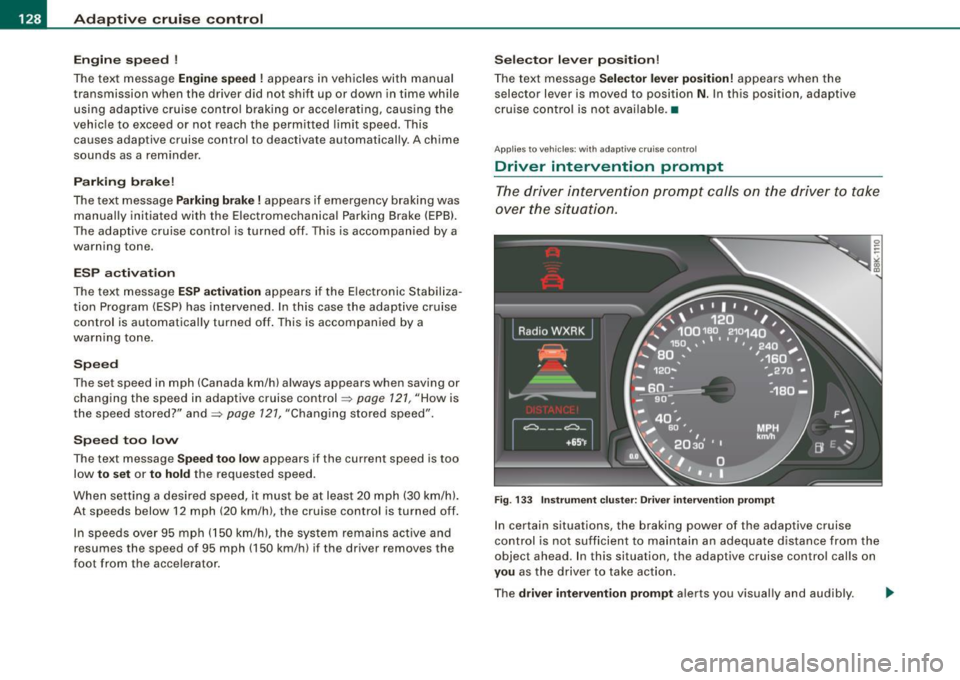
• ..__A_ d_ a-'- p_t _iv _ e_ c_r _u _ i_s _e _ c_o_ n_t _r _o _l _____________________________________________ _
Engin e spee d !
The text message Engine sp ee d ! appears in vehicles with manual
transmission when the driver did not shift up or down in time while
using adaptive cruise contro l braking or accelerating, causing the
vehicle to exceed or not reach the perm itted limit speed. This
causes adaptive cruis e control to deactivate automatically . A chime
sounds as a reminder .
Parking brake !
The text message Parking brake! appears if emergency braking was
manually initiated with the Electromechanica l Parking Brake (EPBl.
The adaptive cruise contro l is turned off . This is accompanied by a
warning tone.
ESP a ctiv ati on
The text message ES P activati on appears if the E lectronic Stabil iza
tion Program (ESP ) has intervened . In this case the adapt ive cruise
control is automatical ly turned off . This is accompanied by a
warn ing tone.
Sp eed
The set speed in mph (Canada km/h ) a lways appears when saving or
changing the speed in adaptive cruise control~
page 121, "How is
the speed stored?" and~
page 121, "Changing stored speed".
Speed too low
The text message Speed too low appears if the cur ren t speed is too
low
to set or to hold the requested speed.
When setting a desired speed , it must be at leas t 20 mph (30 km/h).
At speeds below 12 mph (20 km/h), the cruise control is turned off.
In speeds over 95 mph (150 km/h), the system remains active and
resumes the speed of 95 mph (150 km /h) if the driver removes the
foot from the acce lerator .
Selec tor leve r posit io n!
The text message Selector lever po sition! appears when the
selector lever is moved to pos ition
N . In this position, adaptive
cruise control is no t avai lable. •
Applies to vehi cles : w it h ad apt ive crui se c ontr ol
Driver intervention prompt
The dri ver i ntervention pr ompt c alls on the driver to take
ov er the situation.
F ig . 133 Instrument clu ster : Dr iv e r i nte rv enti on prompt
In certain situations, the braking power of the adaptive cruis e
control is not sufficient to maintain an adequate distance from the
objec t ahead . In this situation, th e adaptive cruise con trol cal ls on
you as the driver to take action .
The
driver intervent ion prompt alerts you visually and audibly. -.,